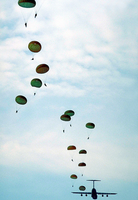








A parachute is a device used to slow the motion of an object through an atmosphere by creating drag, or in the case of ram-air parachutes, aerodynamic lift. Parachutes are usually made out of light, strong cloth, originally silk, now most commonly nylon. Depending on the situation, parachutes are used with a variety of loads, including people, food, equipment, space capsules, and bombs.
In 1907 Charles Broadwick demonstrated two key advancements in the parachute he used to jump from hot air balloons at fairs. His parachute was folded into a pack he wore on his back. And the parachute was pulled from the pack by a static line attached to the balloon. When Broadwick jumped from the balloon, the static line became taut, pulled the parachute from the pack, and then snapped.
In 1911 a successful test was done with a dummy at the Eiffel tower in Paris. The puppet's weight was 75 kg; the parachute's weight was 21 kg. The cables between puppet and the parachute were 9 m long.On February 4, 1912, Franz Reichelt jumped to his death from the tower during initial testing of his wearable parachute.
Also in 1911, Grant Morton made the first parachute jump from an airplane, a Wright Model B, at Venice Beach, California. The pilot of the plane was Phil Parmalee. Morton's device was of the "throw-out" type where he held the parachute in his arms as he left the aircraft. In the same year, a Russian inventor Gleb Kotelnikov invented the first knapsack parachute,although Hermann Lattemann and his wife Käthe Paulus had been jumping with bagged parachutes in the last decade of the 19th century.
In 1912, on a road near Tsarskoye Selo, years before it became part of St. Petersburg, Kotelnikov successfully demonstrated the braking effects of a parachute by accelerating a Russo-Balt automobile to the top speed, and then opening a parachute attached to the back seat, thus inventing also the drogue parachute.
On March 1, 1912, U.S. Army Captain Albert Berry made the first (attached-type) parachute jump in the United States from a fixed-wing aircraft, a Benoist pusher, while flying above Jefferson Barracks, St. Louis, Missouri. The jump utilized a "pack" style parachute stored or housed in a casing on the jumper's body.
Štefan Bani? from Slovakia built the first parachutes to see use beyond the experimental stage, patenting it in 1914.He tested his umbrella-like device by jumping from an airplane with it, and sold (or donated) the patent to the United States military, receiving very little money or fame for it.On June 21, 1913, Georgia Broadwick became the first woman to parachute jump from a moving aircraft, doing so over Los Angeles, California.In 1914, while doing demonstrations for the U.S. Army, Broadwick deployed her chute manually, thus becoming the first person to jump free-fall.
The first military use of the parachute was by artillery observers on tethered observation balloons in World War I. These were tempting targets for enemy fighter aircraft, though difficult to destroy, due to their heavy anti-aircraft defenses. Because it was difficult to escape from them, and dangerous when on fire due to their hydrogen inflation, observers would abandon them and descend by parachute as soon as enemy aircraft were seen.